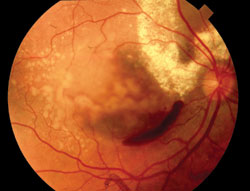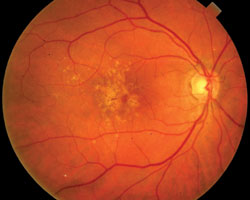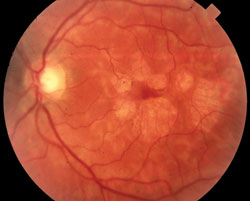Lifestyle changes, nutrients slow progression of AMD
Research has shown that intake of lutein, zeaxanthin, omega-3 fatty acids and beta carotene (in non-smokers) can reduce risk.
Click Here to Manage Email Alerts
Recent studies show the benefits of dietary carotenoids and omega-3 fatty acids in the prevention of age-related macular degeneration, though obese patients, patients who smoke and those with an unhealthy lifestyle are more apt to trigger AMD than healthy patients despite supplementation.
Role of carotenoids
As reported in the Age-Related Eye Disease Study (AREDS Report #22), a higher dietary intake of macular carotenoids was independently associated with a decreased likelihood of having neovascular AMD.
 Figure 1. Home monitoring devices can be used to warn patients of the progression to wet AMD (pictured). Images: Alexander LJ |
According to the study, carotenoids such as lutein and zeaxanthin are strong antioxidants that selectively accumulate in the retina and filter damaging blue light and reduce oxidant stress, which may reduce photochemical damage and the generation of reactive oxygen species.
Though supplementation of these carotenoids may aid some at-risk patients, Larry J. Alexander, OD, told Primary Care Optometry News in an interview that two eggs eaten three times a week is the ideal natural food source for lutein and zeaxanthin.
Omega-3 fatty acids
Higher levels of omega-3 fatty acid intake were shown to reduce the risk of AMD in AREDS Report #20. The protective effect of omega-3 fatty acids promotes healthy eye tissue and regulates inflammatory and immune responses in the retina, which improves endothelial cell function and thereby reduces the risk of AMD, the U.S. Twin Study of Age-Related Macular Degeneration found.
 Figure 2. At risk and confirmed dry AMD (pictured) patients are encouraged to take nutrients. |
As there is increasing evidence that AMD has an inflammatory component, Dr. Alexander notes the importance of omega-3 fatty acids in the primary and secondary prevention protocols of AMD.
“Supplementation with fish oil is probably as important — if not more important — than supplementation with lutein and zeaxanthin,” Dr. Alexander said. “The studies are showing that fish oil synergistically enhances macular pigment.”
Limit beta carotene in smokers
An established risk factor of AMD, smoking increases oxidative stress, platelet aggregation and fibrinogen levels (viscosity) and reduces high-density lipoprotein levels, serum carotenoids and other antioxidants in the blood such as vitamin C. According to the U.S. Twin Study, smoking increases the risk of AMD by 32%.
In large clinical trials sponsored by the National Cancer Institute, beta carotene (vitamin A) was shown to increase the risk of lung cancer in current smokers and high doses are, thus, contraindicated for smokers to combat AMD. Vitamin A may in fact increase the risk of advanced AMD by potentiating the development of geographic macular degeneration, Michael J. Tolentino, MD, said in an interview.
Encourage a healthy lifestyle
The most significant change a patient can make when diagnosed with AMD is to lead a healthier lifestyle, Dr. Alexander said. The recommendations published by the American Heart Association (www.heart.org) should be followed by AMD patients with the addition of lutein, zeaxanthin and omega-3 fatty acids.
 Figure 3. Vitamin A may increase the risk of advanced AMD by potentiating the development of geographic macular degeneration (pictured). |
“Whatever you can do to help your situation with your heart is going to help your situation with macular degeneration,” Dr. Alexander told PCON. “The advice to patients is to eat more fiber, lose weight, eat less fat, exercise, stop smoking, take fish oil and get lutein and zeaxanthin in your body. Obesity is a significant issue for these patients; no matter how much carotenoids you take, your body will only slowly release it from adipose tissue for use in the retina.”
Dr. Tolentino recommends that at risk and confirmed dry AMD patients take nutrients based on the AREDS formulation minus vitamin A to decrease the risk of conversion to wet AMD.
“I also encourage the use of the carotenoids meso-zeaxanthin, zeaxanthin and lutein as well as omega-3 fatty acid supplementation high in docosahexanoic acid,” Dr. Tolentino told PCON. “I discuss with patients that this evidence is derived from epidemiological and basic science data, and that one can increase the intake of some of these carotenoids and fats by adjusting his or her diet.”
Stuart Richer, OD, PhD, FAAO, emphasizes the importance of primary prevention for children of AMD patients, a vulnerable high-risk population that is not directly addressed in the AREDS 2 study. According to Dr. Richer, the same public health principles recommended for high-risk AMD retinopathy apply to this group as well.
Macular pigment technology
Enhancing macular pigment density through supplementation, which is possible in about 75% of patients, is essential for aging drivers suffering from AMD due to reduced visual acuity, lower contrast sensitivity and glare recovery ability, Dr. Richer told PCON. Macular pigment technology combined with a glare recovery measurement and low contrast reading card or CSF measurement can show physicians subtle changes in nutrient intake far more accurately than a high contrast Snellen chart.
“Optometrists do a disservice to patients older than 50 with mild and moderate AMD by claiming that their vision is fine when they measure 20/20 foveal vision, which is preserved with age even in advanced AMD,” Dr. Richer said. “They should invest in contrast sensitivity, glare and macular pigment technology and use these for any patient with high-risk AREDS retinal pathology, a strong AMD risk factor such as smoking, a family history of AMD, photophobia, diabetes, patients in the transportation industry and athletes. Applying these technologies is essential at baseline as well as evaluating the effects of lifestyle and prescriptive carotenoid supplementation.”
Dr. Tolentino suggests monitoring patients with this technology to gauge carotenoid and fat intake and increase awareness in regard to the disease.
OCT, PHP technology
Spectral domain OCT is the experts’ preferred method to monitor high-risk AMD patients. Preferential hyperacuity perimetry (PHP) home monitoring also has value in helping patients independently assess their vision, Dr. Tolentino said.
“I tell patients that this home monitoring device serves as an early warning system for the development of wet AMD, which is important in the current age of effective treatments. It gives both patients and doctors some peace of mind,” he said.
The potential future of genetic testing may also be valuable in identifying the subpopulation of patients that have mutations affecting the carotenoid cycle or the fat cycle, indicating the necessity of additional supplementation before AMD develops, Dr. Tolentino said.
No ‘simple’ solution
Though new technology and the advent of supplementation for dry AMD is a source of comfort for both patients and physicians, Dr. Alexander cautions against being led into a false sense of security with these developments.
“There’s no simple solution, because every patient is different,” Dr. Alexander said. “AMD is a lot more complicated than which supplement to recommend. If a patient inherits the genetic tendency and triggers those genetics by an unhealthy lifestyle that includes smoking, obesity and a diet lacking in essential nutrients, they will be more prone to macular degeneration.” — by Stephanie Vasta
References:
- Age-Related Eye Disease Study Research Group, SanGiovanni JP, et al. The relationship of dietary carotenoid and vitamin A, E, and C intake with age-related macular degeneration in a case-control study: AREDS Report No. 22. Arch Ophthalmol. 2007;125(9):1225-1232.
- Li B, Ahmed F, Bernstein PS. Studies on the singlet oxygen scavenging mechanism of human macular pigment. Arch Biochem Biophys. 20101;504(1):56-60. Epub 2010 Aug 1.
- Parekh N, et al., for the CAREDS Research Study Group. Association between dietary fat intake and age-related macular degeneration in the carotenoids in Age-Related Eye Disease Study (CAREDS): An ancillary study of the Women’s Health Initiative. Arch Ophthalmol. 2009;127(11):1483-1493.
- Seddon JM, George S, Rosner B. Cigarette smoking, fish consumption, omega-3 fatty acid intake and association with age-related macular degeneration: The U.S. Twin Study of Age-Related Macular Degeneration. Arch Ophthalmol. 2006;124(7):995-1001.
- Larry J. Alexander, OD, can be reached at 4500 Knightsbridge Drive, McKinnley, TX 75070; larryalexander@tx.rr.com.
- Michael J. Tolentino, MD, is a Primary Care Optometry News Editorial Board member. He can be reached at 250 Avenue K, SW, Winter Haven, FL 33880; (863) 297-5400; miket@crmd.net; www.crmd.net.
- Stuart Richer, OD, PhD, FAAO, is chief of optometry at Department of Veterans Affairs North Chicago and associate professor of Family & Preventive Medicine at Rosiland Franklin University of Medicine and Science/Chicago Medical School. Dr. Richer is also an associate professor of optometry at UMSL and Illinois College of Optometry. He can be reached at 3001 Green Bay Rd., North Chicago, IL 60064-3095; (224) 610-5440; fax: (224) 610-2924; Stuart.Richer1@Med.VA.Gov.

